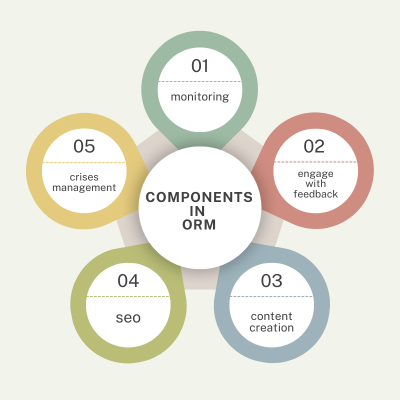
What is orm in digital marketing?
Online reputation management, or ORM in digital marketing, simply means watching over, shaping, and protecting a company’s or person’s online reputation. ORM aims to influence what people think by managing search engine results, social media mentions, and online reviews. To keep up with a good online reputation, it entails addressing customer concerns, sharing good positive content, and responding to negative comments.
ORM helps companies expand their customer base, build credibility on the brand, and create trust by keeping the online reputation healthy.
Components of ORM in digital marketing
Monitoring:
Continuously track brand mentions across social media, review sites, and search engines. This helps identify customer sentiment and address issues early, using tools like Google Alerts or ORM software.
Engage with feedback:
Respond to complaints, thank customers, or appreciate positive comments. It shows respect for customers, develops trust, and sometimes can undo damage caused by nasty reviews or online criticism.
Content creation
Creates great content like blogs, articles, or social media posts. This Clearly Displays Brand Values And Successes Online Visibility Creates A Good Perception Of The Brand.
SEO:
Positive content gets better ranking on search engines. Negative mentions in results go further down the list; favourable content is more visible to people searching for your brand.
Engagement:
Reach out to customers, both online and also in deeper connections that develop trust. It keeps answering questions, comments, or reviews to stay loyal and fosters a friendly community around your brand.
Crisis Management:
The ability to respond quickly to negative events such as bad reviews or a PR crisis. Timely and strategic response ensures no reputational damage and helps regain control of the situation.

Factors affecting ORM in digital marketing
Customer Reviews:
Whether negative or positive, reviews flooding on Google, Yelp, and other social media websites determine the reputation of a brand.
Social media activity:
A brand’s ability to engage with audiences, address questions, and even handle criticism on social media can greatly determine public perception.
Search Engine Results:
However, whatever content—whether negative or positive—is found on the search results would definitely affect the perception of a brand.
Online content:
Blog posts, news articles, and any other forms of online information that represent the brand image are critical factors for establishing the brand’s reputation by the tone and reach of the content.
Competitor's behaviours:
Competitors may create a negative threat by accusing a brand of something, comparing, or posting false reviews.
Proper customer service:
Quick, efficient, and helpful responses in the situation of a customer’s concerns. Poor services lead to a tarnished reputation.
Influencer Opinions:
The remarks of influencers or notable figures regarding a brand, whether expressed through reviews or endorsements, can profoundly influence online reputation management.
Crisis Response:
How a brand handles its PR crisis—whether scandal or data breach—virtually determines the success of its long-term management of reputation.
Brand transparency:
Is the openness and honesty on issues like product recalls or service issues. It builds confidence and credibility.
Third-party Websites:
Content on other sites, such as news sites or niche forums, can either positively or negatively contribute towards brand perception ada
Advantage of effective orm
Enhanced Brand Image:
ORM helps your company build a good online presence, thereby enhancing how your customers perceive your brand. A good reputation creates new prospects and bolsters loyalty among existing customers.
Increased Trust and Credibility:
Actively managing your online reputation builds trust with customers. Responding to feedback and showcasing positive content signals reliability and enhances customer confidence in your brand.
Improved customer relationships
An increased engagement with customers by means of response and interaction helps improve relationships. This may add to customer satisfaction and loyalty, especially in repeat business.
Search Engine Rankings:
A good ORM campaign increases positive content, thus increasing visibility through search results. Consequently, it is more likely that prospects will find positive information about your brand.
Crisis Mitigation:
ORM equips businesses to tackle negative situations with agility, thereby minimising potential harm to their reputation. By responding quickly and strategically to crises, they can preserve customer trust and loyalty.
How to analyse your online reputation
Watch what people are saying:
Set up alerts. Use tools such as Google Alerts, where you could tell them that you want to be told whenever your brand is mentioned online—that is, on news articles, blog posts, or social media. It’s like having a helper that tells you every time someone talks about you!
Check customer reviews:
Check reviews that are posted on Google, Yelp, or even on social media. Pay attention to both good and bad. This helps you see where your customers like it and what you can improve on.
Check your social media:
Look at your social media pages and view how people have been responding to your posts. Are they liking, sharing, or commenting? A lot of engagement usually indicates that people think positively of your brand. Low engagement might suggest otherwise.
Google Yourself:
Type in your brand name on Google and see what comes up. What matters most is the first page, because that’s what potential customers will be viewing. Look for positive articles or reviews and identify anything negative that you may want to correct.
Check Out Your Competition:
Look at what is being talked about by your competitors online. It can give you a good idea of where you stand against them and what you might want to do differently.
Use Reputation Tools:
Consider using online tools such as Reputation.com or ReviewTrackers. These solutions may give you an idea of what other people see in your brand and may help you notice changes that happen over time, simplifying your analysis.
Ask your customers directly:
Provide surveys or feedback forms to your customers. Ask them about their experiences and what they feel about your brand. This feedback can be very helpful.
Check Your Own Content:
Reflect on articles or posts you may have created. Which ones are those that attract the most number of viewers? Knowing what really works will guide you in churning out more of those same contents that people enjoy, further building your reputation. By doing all the above steps, you see how people are seeing and viewing your brand. This will give you an idea of how you can manage your reputation, respond to feedback, and even improve your interaction with customers!
orm practices and strategies
1. Scanning the World
Set alerts: Employ Google Alerts, Mention, or Social Mention tools to get notifications whenever anyone mentions your brand in cyberspace.
Social Listening: Keep track of the regular traffic in all social media pertaining to the industry or sector brand. Engage in relevant conversations to be seen.
2. Giving Responses to Customers Upon Especially Negative Feedback
Timely Responses:
Answer within the shortest time possible, pleasant or unpleasant feedback. Show concern for what clients’ say and give feedback towards that end.
Individualised Strategies: Do not have blanket fixes—type solutions. Solutions are restrictive to the area and circumstances of the client and tend to be more authentic.
3. Promoting Definite Feedback
Requesting Reviews: Encourage satisfied clients to help post positive feedback on sites such as Google, Yelp or TripAdvisor. Make it easy for them and provide them link and even assistance.
Solicit Review: Encourage consideration of benefits(which could be a discount or even free product) to be offered to customers who post positive reviews while adhering to policies of the platform.
4. Content Development
Make Sure Good Content is Available: At all times maintain a steady flow of relevant and important content addressing the concern of the business whether it be blogs, videos, infographics or social media.
Use Customer Testimonials and Cases: Use customer reviews and case studies focusing on their experiences with your company and how they were helped.
5. Search Engine Optimization SEO
Optimise Positive Things Content: Make sure that the website and positive content of the organization is search engine optimised. Include use of high, relevant keywords, and meta tags and back linking strategies.
Make a Strong Online Presence: Have an active professional website and social media but more importantly where you will appear in the searches helping curtail negative mentions.
Conclusion
Orm in digital marketing is the key to this digital era. Online reputation management contributes to making and keeping good images of brands in place. Effective ORM strategies, such as proactive monitoring, responding to customer comments on the brand, and creating optimised content, improve the reputation of business, gain customer trust, and aid growth. The healthy online reputation not only attracts new customers but also reinforces loyalty in the existing one. ORM will help companies to be fast in case of any kind of bad crisis situation so that negative effects on them would be lower, and in the long term, resiliency increases. A business or brand comes to appear as the leader when their digital appearance is followed continuously and with improvements in them, to a basis of more competitive markets, so as to grow successfully for the long time.
